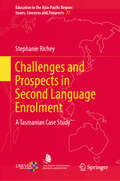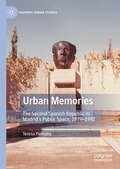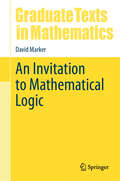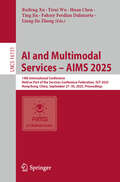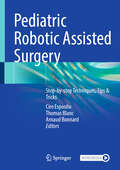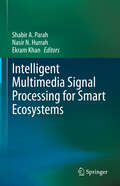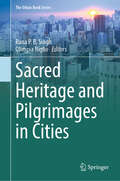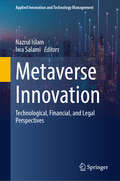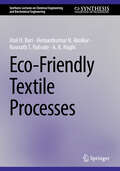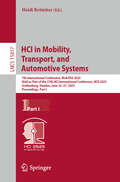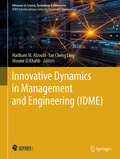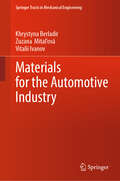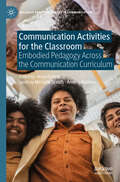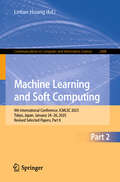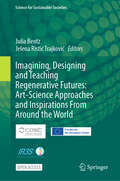- Table View
- List View
Challenges and Prospects in Second Language Enrolment: A Tasmanian Case Study (Education in the Asia-Pacific Region: Issues, Concerns and Prospects #77)
by Stephanie RicheyThis book provides a contextual examination of the factors that affect students&’ elective second language (L2) study in Australia. It investigates why Tasmanian students do or do not choose to enrol in an elective second language at school and explores relationship of motivational factors that affect their decisions. This is a case study of one education system, but the findings are relevant to others globally. With the field of L2 research turning attention to motivations around languages other than English (LOTEs), this book provides a unique account of adolescent students&’ LOTE experiences in an Anglophone setting. It demonstrates there is a complex ensemble of factors that affect subject choice and enrolment decisions regarding elective second language learning. In the face of Global English, these findings address a gap in the research of adolescent LOTE learners, the majority of who have English as a first language, and thus motivations for language learning vastly differ from those wanting to learn English as an additional language. The findings outlined in this book are valuable as they consider the practical implications for school language programmes. This book will be of interest to scholars, teachers, and policy makers globally wishing to gain further insight into motivational factors affecting L2 enrolment.
Urban Memories: The Second Spanish Republic in Madrid’s Public Space, 1979–1992 (Hispanic Urban Studies)
by Teresa PinheiroThe book explores the symbolic emergence of the Second Spanish Republic in Madrid&’s public space in the aftermath of Francisco Franco&’s dictatorship. Despite the constraints of a transition to democracy premised on restoring the Bourbon monarchy and promoting national reconciliation, Madrid provided exceptional conditions for recovering republican memory. The city&’s left-wing administration, elected in the first democratic municipal election in 1979, pursued a cautious yet affirmative politics of memory toward Spain&’s republican past. Drawing on empirical research, the study focuses on mnemonic materialisation of the Second Spanish Republic through street nomenclature, monuments and plaques established between 1979 and 1992. Most of these memorials endure to this day, having withstood contestation, theft and vandalism. By reconstructing their emergence and tracing their evolving public presence, the book offers a nuanced account of how democratic memory practices took shape amid the tensions and contradictions of Spain&’s negotiated political transition.
Migräne: Diagnostik - Therapie - Prävention
by Hartmut GöbelDas vorliegende Buch gibt einen Überblick über Diagnostik, Therapie und Prävention der Migräne. Es wurde von einem führenden Wissenschaftler auf dem Gebiet verfasst und wendet sich an alle Ärztinnen und Ärzte, die Patientinnen und Patienten mit Migräne versorgen, z.B. in der Inneren Medizin, Allgemeinmedizin, Schmerztherapie oder Neurologie. Themen sind u.a. Phasen der Migräne und Triggerfaktoren - Diagnostik und Differenzialdiagnose - Verlauf und Prognose - medikamentöse und nichtmedikamentöse Therapie - Prophylaxe der Migräne - chronische Migräne und Kopfschmerz bei Medikamentenübergebrauch - Migräne bei Kindern und Frauen. Die 2. Auflage erscheint komplett aktualisiert und thematisiert u.a. die bemerkenswerten Fortschritte, die in der Migräneforschung und Migränetherapie in den letzten Jahren erzielt wurden. Dazu zählen eine moderne Präzisionsmedizin, die gezielt in die Steuerung von Neurotransmittern und Neuropeptiden eingreift ebenso wie neue Therapien mit Triptanen, monoklonalen Antikörpern, Gepanten, Ditanen, Neurotoxinen und Neuromodulation, die die Behandlungsmöglichkeiten revolutioniert und individuelle Ansätze zur nachhaltigen Linderung eröffnet haben.
Digital Transformation in Retail: A Comprehensive Analysis of Technology Acceptance and Consumer Behavior (Handel und Internationales Marketing Retailing and International Marketing)
by Theresia MennekesRetail is undergoing profound change, driven by digitalization, shifting consumer behavior, and recurring crises. Small and medium-sized retailers face the challenge of using limited resources to leverage digital technologies, strengthen resilience, and remain customer-focused. This work examines how digital transformation reshapes the retail value chain, the opportunities and risks that arise, and the capabilities required to stay competitive. The work also explores consumer behavior, both in times of crisis and among vulnerable groups such as children. It analyzes how external shocks like inflation or pandemics influence purchasing decisions, what factors shape children&’s consumer competence, and how the presence of small and large retailers differs on digital platforms. With an interdisciplinary approach, the work integrates concepts such as resilience, dynamic capabilities, and technology acceptance. It provides practical insights for designing future-proof retail models while raising awareness of the broader societal implications of digitalization in retail.
An Invitation to Mathematical Logic (Graduate Texts in Mathematics #301)
by David MarkerIn addition to covering the essentials, the author’s intention in writing this text is to entice the reader to further study mathematical logic. There is no current “standard text” for a first graduate course in mathematical logic and this book will fill that gap. While there is more material than could be covered in a traditional one semester course, an instructor can cover the basics and still have the flexibility to choose several weeks’ worth of interesting advanced topics that have been introduced. The text can and will be used by people in various courses with different sorts of perspectives. This versatility is one of the many appealing aspects of this book. A list of suggested portions to be covered in a single course is provided as well as a useful chart which maps chapter dependencies. Additionally, a motivated student will have ample material for further reading. New definitions, formalism, and syntax have been streamlined to engage thereader quickly into the heart of logic and to more sophisticated topics. Part I and Part IV center on foundational questions, while Part III establishes the fundamentals of computability. Part II develops model theory, highlighting the model theory of the fields of real and complex numbers. The interplay between logic and other areas of mathematics, notably algebra, number theory, and combinatorics, are illustrated in Chapters 5, 6, 8, 14, and 16. For most of the text, the only prerequisite is mathematical maturity. The material should be accessible to first year graduate students or advanced undergraduates in mathematics, graduate students in philosophy with a solid math background, or students in computer science who want a mathematical introduction to logic. Prior exposure to logic is helpful but not assumed.
Robotic Hernia Surgery
by Omar Yusef Kudsi Ulrich A. Dietz Guido Beldi Armin Wiegering René FortelnyThe possibilities and limitations of robot-assisted hernia surgery are presented in this book by an international team of authors in all their facets. The focus is on step-by-step descriptions of individual procedures for different indications and the detailed description of the anatomical conditions as they appear to the surgeon during the robot-assisted approach. Numerous drawings and surgical photographs, specially created for the book, illustrate the presentation and are complemented by a total of 16 videos of the surgical procedures, which can be accessed from the book using the publisher's MoreMedia app. Additional chapters address patient-related and scientific foundations and consider the procedures in their social and economic context.
AI and Multimodal Services – AIMS 2025: 14th International Conference, Held as Part of the Services Conference Federation, SCF 2025, Hong Kong, China, September 27–30, 2025, Proceedings (Lecture Notes in Computer Science #16151)
by Liang-Jie Zhang Ruifeng Xu Huan Chen Ting Jin Yirui Wu Fahmy Ferdian DalimartaThis book constitutes the refereed proceedings of the 14th International Conference on AI and Multimodal Services – AIMS 2025, held as Part of the Services Conference Federation, SCF 2025, in Hong Kong, China, during September 27–30, 2025. The 9 full papers included in this book were carefully reviewed and selected from 22 submissions. They focus on for the development, publication, discovery, orchestration, invocation, testing, delivery, certification, and management of artificial intelligence (AI) and multimodal applications and services.
Pediatric Robotic Assisted Surgery: Step-by-step Techniques, Tips & Tricks
by Ciro Esposito Arnaud Bonnard Thomas BlancThis practical manual of Pediatric Robotic Assisted Surgery (RAS) covers all the aspects of pediatric RAS and provides readers with a practical and up-to-date resource detailing the specific needs and the special considerations surrounding the minimally invasive care of children. The technical aspects of each intervention are described in detail both in the text and in the video accompanying the chapters, and the management of robotic complications is described and discussed in an accessible style. Written by world-renowned experts in pediatric robotic surgery, the volume will be an unvaluable resource for pediatric surgeons of all disciplines, as well as for residents and hospital managers.
Intelligent Multimedia Signal Processing for Smart Ecosystems
by Shabir A. Parah Nasir N. Hurrah Ekram KhanA smart ecosystem is envisioned to exchange and analyze data across systems, enabling a flexible, faster, and reliable smart ecosystem for high-quality results at reduced costs and little human intervention. This book introduces many innovative approaches and provides solutions to various problems of smart ecosystems designed by employing various techniques/models based on AI, ML, Deep Learning, and the Internet of Things (IoT). The main focus is on intelligent multimedia processing and automated decision-making for various services, real-time data analysis, data security, cost-effective solutions for multimedia applications, smart information processing systems, and smart city planning to name a few. In addition, this book presents some key insights and future directions in the various areas of technology. Throughout the book, many state-of-the-art solutions concerning various applications are proposed to solve the issues and ensure the quality of services (QoS). The authors discuss the limitations of the current techniques used to design a smart ecosystem and highlight some prospective areas of research in the future. The book comprehensively discusses multimedia processing of various forms of data comprising text, images, and audio for the implementation of various solutions. The book is aimed to open many areas of research and thus would present a comprehensive reference for the design of smart ecosystems in various applications.
Experimentelle Pflanzenökologie: Grundlagen und Anwendungen (Springer Reference Naturwissenschaften)
by Rainer Matyssek Werner B. HerppichAllen, die mit Planung, Durchführung und Auswertung von pflanzenökologischen Experimenten zu tun haben, bietet dieses Handbuch eine zuverlässige Basis. Die Autoren beschreiben die biophysikalischen, physikalisch-chemischen und ökophysiologischen Grundlagen der experimentellen Pflanzenökologie sowie die Interaktionen zwischen Pflanzen und abiotischen Faktoren. Schwerpunktmäßig konzentrieren sie sich dabei auf Teilbereiche, die für den Freilandeinsatz von hoher Bedeutung sind. So behandeln sie insbesondere Fragen des Kohlenstoff- und des Wasserhaushaltes. Dabei werden einzelne Aspekte gezielt vertiefend behandelt, auf ein oberflächliches Ansprechen möglichst vieler Teilbereiche dagegen verzichtet. Mineralstoffhaushalt und Bodenökologie wurden als Themen bewusst ausgeklammert, da für diese zum Teil andere wissenschaftliche und methodische Anforderungen gelten. Die Darstellung und Erläuterung von Messtechniken und Arbeitsmethoden der modernen experimentellen Pflanzenökologie, ergänzt durch eine Vielzahl von Forschungsbeispielen, bilden den Schwerpunkt dieses Buches. Das Werk basiert auf zwei vorangegangenen Auflagen gleichen Titels „Experimentelle Pflanzenökologie, Grundlagen und Anwendungen“ von Dieter von Willert, Rainer Matyssek und Werner B. Herppich, Thieme 1995 (1. Auflage), sowie Rainer Matyssek und Werner B. Herppich, Springer Nature 2019 (2. Auflage). Diese vorliegende 3. Auflage wurde ein weiteres Mal stark überarbeitet und erweitert.
Dramatic Intellectuals (Cultural Sociology)
by Javier Pérez-Jara Nicolás RudasThis edited volume advances meaning-centered approaches to understanding the social construction of public intellectuals and their enduring influence on contemporary societies. The contributors reject reductionist perspectives that depict intellectuals and their ideas as mere byproducts of broader social forces. Instead, the volume champions a multidimensional approach that recognizes the semi-autonomy and causal power of intellectual discourses. At the core of this framework is the concept of dramatic intellectuals—figures who navigate collective anxieties and hopes, shaping public discourse through master narratives of salvation and catastrophe, utopia and apocalypse. Through diverse case studies, the volume identifies key features of their master stories, including stark binaries, the social construction of meta-adversaries and meta-saviors, the mobilization of cultural traumas and ideological packs, and the Cassandra complex. Each chapter examines at least one pivotal dramatic intellectual within her cultural context, exploring how these figures shape public discourse and collective imagination. The volume covers a diverse range of intellectuals, including Karl Marx, Sigmund Freud, Carl Jung, Frantz Fanon, Jean-Paul Sartre, Bertrand Russell, Noam Chomsky, Arne Naess, Ingemar Hedenius, Ayn Rand, Otis Eugene &“Gene&” Ray, Pedro Almodóvar, Agustín Laje, Slavoj Žižek, Jordan Peterson, and Giorgio Agamben. Beyond detailed case studies, the book lays the groundwork for new research agendas in the sociology of intellectuals. This book will be essential reading for scholars of cultural sociology.
Green Chemistry Methods for Producing Biopolymeric Nanomaterials (Smart Nanomaterials Technology)
by Kamel A. Abd-ElsalamThis book is a thorough guide that navigates the convergence of environmentally friendly techniques and cutting-edge nanotechnology. This book tackles the growing demand for eco-friendly techniques for nanomaterial production, as tailored by academics, scientists, and experts in materials science, nanotechnology, and green chemistry. The primary subjects discussed are novel green synthesis methods for generating biopolymeric nanomaterials, with a focus on minimizing environmental effects and resource depletion.The book investigates eco-friendly alternatives to traditional nanomaterial fabrication by leveraging biopolymers produced from renewable sources as major building blocks. Readers will learn about green chemical principles, green solvents, and energy-efficient processes, which will help them reduce their carbon footprint and waste output. The importance of these topics lies in the urgent need to shift toward environmentally conscious practices in nanotechnology, considering the escalating concerns over pollution and resource depletion associated with traditional methods.The overarching problem addressed is the environmental toll of conventional nanomaterial production. By presenting green chemistry methodologies, the book seeks to provide actionable solutions to reduce the ecological footprint of nanotechnology, ensuring the sustainable development of advanced materials. Through a holistic approach, it offers a roadmap for researchers and practitioners to adopt greener practices in the synthesis of biopolymeric nanomaterials, fostering a paradigm shift toward environmentally responsible nanotechnology.This book is intended for anyone who wants to use green and sustainable approaches to create biopolymeric nanomaterials. The book is intended for people looking for novel and environmentally responsible techniques for nanomaterial synthesis. Furthermore, the book may appeal to graduate students and postdoctoral researchers in the field who are looking for comprehensive and up-to-date information on green production processes and uses of biopolymeric nanomaterials. It serves as a valuable resource for those wanting to deepen their knowledge in this emerging field and explore new perspectives on sustainable nanomaterial synthesis.
Circular Economy and International Law (Juridicum – Bochumer Schriften zur Friedenssicherung und zum Humanitären Völkerrecht I Bochum Studies on the International Law of Peace and Armed Conflict #70)
by Vivien WefringhausOur earth&’s supply of natural resources is depleting while mountains of waste are piling up. Killing two birds with one stone, scientists recommend a transformation towards a circular economy. Nevertheless, explicit regulation to implement such an economic model is still missing. With due regard to the global scope of the increasing this issue, the question arises whether relevant rules on these issues can be extracted from existing international law. This book examines if an integrated analysis of different fields of international law leads to an implicit obligation for states to undertake a transition towards a circular economy. By assessing the related provisions under international environmental law as well as under human rights law, it aims to reveal if they imply a mandatory economic shift. The analysis will differentiate between relevant provisions concerning the issue of resource depletion on the one hand, and the current law governing waste management on the other hand. In a second step, the environmental and social demands will be balanced with the states&’ sovereignty in order to determine if an implicit obligation to transform the economy can be detected.
Behavioral Neuroscience of Alcohol Addiction: Translational Studies and Human Phenotypes (Current Topics in Behavioral Neurosciences #72)
by Rainer Spanagel Wolfgang H. SommerBehavioral Neurobiology of Alcohol Addiction explores the forefront of addiction research, integrating fundamental neurobiological mechanisms with translational insights into human phenotypes. Alcohol addiction remains a major public health concern with extensive medical and societal implications. Understanding its intricate interplay between neurobiology, behavior, and treatment is essential for developing effective interventions. This edition is structured into two volumes: Basic Mechanisms and Animal Studies and Translational Studies and Human Phenotypes. The first volume examines addiction conceptualization, stress and reward systems, and chronic pain. It further explores the cellular, synaptic, and circuit-level consequences of alcohol, incorporating computational and neuroimaging approaches. It also addresses the replication crisis in preclinical research and proposes guidelines to mitigate its impact. The second volume shifts the focus to human studies, covering human laboratory approaches, ecological momentary assessment, molecular imaging, and the challenges of bridging preclinical and clinical research. The book also highlights emerging treatments, including psychological interventions, neuromodulation techniques, and the role of the gut-brain axis. Alcohol use fundamentally alters mood states via brain mechanisms—an insight widely acknowledged by experts and laypeople alike. However, debates surrounding the brain disease model of addiction have intensified in recent years. This collection of articles contributes to this ongoing discussion by reinforcing the importance of a neurobiological perspective in addiction science and demonstrating how advances in neuroscience translate into more effective therapeutic approaches. Written by leading experts in the field, both volumes provide a comprehensive yet accessible resource for addiction researchers, neuroscientists, clinicians, and students. The book aims to deepen the understanding of alcohol addiction and inspire new directions in research and treatment.
Sacred Heritage and Pilgrimages in Cities (The Urban Book Series)
by Olimpia Niglio Rana P. B. SinghThis book aims to examine the role and status of sacred cities in the context of the United Nations Sustainable Development Goals and associated cultural and sacred landscapes with an emphasis on awakening the deeper cultural sense in harmonising the world and enhancing religious and spiritual tourism—all in the frame of &“Future of the Earth&”. The book adds a new dimension of cultural understanding to the broad domain of emerging human geoscience, which is considered as a platform for contributing to the role of holy-heritage cities towards sustainable development. Chapters include contributions from Austria, Canada, China, Germany, India, Indonesia, Italy, Japan, Korea, Lithuania, Sri Lanka, the UK, and the USA. Interfacing heritage cities and pilgrimages is a global concern in the contemporary world, which covers many points of view of the common impacts of socio-economic-cultural and jurisprudence planning, wellbeing and related domains. Concerned with the complex interactions between development and environment, the aim is to seek paths and implications for framing sustainability in all social activities through the status and role of holy-heritage cities. &“As many essays in this book examine, striking a proper balance between the &“tourist&” and &“pilgrim&” uses of sacred sites remains a major concern, particularly in urban contexts.&” (Prof. Francesco Bandarin, (ex) Director, UNESCO World Heritage Centre, Paris). &“This book is a masterpiece that illuminates the multitude of relationships between sacred space, urban environments, religious heritage, and pilgrimages.&” (Prof. Dallen J. Timothy, Arizona State University, Phoenix, USA). &“The book, genuinely an important collection of papers, has focussed on the interrelationship, interaction, and transformations in sacred heritage and pilgrimages in cities.&” (Prof. Rima Hooja, President, ICOMOS India, SPA- New Delhi, India). &“This book, the first of its kind, paves a solid path for understanding the interfaces between sacred heritage and pilgrimages in cities, which will help to strengthen cultural sustainability.&” (Emer. Prof. Taigen Hashimoto, Indology, Toyo University, Tokyo, Japan).
Metaverse Innovation: Technological, Financial, and Legal Perspectives (Applied Innovation and Technology Management)
by Nazrul Islam Iwa SalamiThe Metaverse can be defined as an immersive 3-D simulated digital environment that deploys technologies like augmented reality, virtual reality, blockchain, and artificial intelligence to imitate the real world and allow people to conduct daily activities through digital versions of themselves (avatars). The opportunities brought by the metaverse for the economy and the society are wide in scope from business models to equitable education possibilities. This prompts regulators and policymakers around the world to assess the crucial legal and regulatory issues that arise in the process of metaverse development. This book offers a comprehensive understanding of metaverse innovation from technological, financial, and legal perspectives. It offers the basics of the metaverse, such as its enabling technologies, main characteristics and the global trends that shape its development. It also reviews the positive and negative impact of the metaverse on different sectors of the economy as well as the implications for policy and law.
Eco-Friendly Textile Processes (Synthesis Lectures on Chemical Engineering and Biochemical Engineering)
by A. K. Haghi Hemantkumar N. Akolkar Navnath T. Hatvate Atul H. BariThe textile industry is a major environmental polluter. Despite some progress in textile treatment processes and in energy saving, progress is slow, and CO2 emissions continue to rise. In order to better manage the environmental impact of textile treatment processes, it is necessary to understand their principles to be able to improve or replace them with a more environmentally friendly process. This book begins by introducing sustainable practices in the textile industry that are less polluting followed by eco-friendly finishing treatments. Next, the principle of heat and mass transport in fabrics and the practical applications of these theories are explained. Finally emerging environmentally friendly technologies are discussed.
HCI in Mobility, Transport, and Automotive Systems: 7th International Conference, MobiTAS 2025, Held as Part of the 27th HCI International Conference, HCII 2025, Gothenburg, Sweden, June 22–27, 2025, Proceedings, Part I (Lecture Notes in Computer Science #15817)
by Heidi KrömkerThis book constitutes the refereed proceedings of the 7th International Conference on HCI in Mobility, Transport, and Automotive Systems, MobiTAS 2025, held as part of the 27th HCI International Conference, HCII 2025, which took place in Gothenburg, Sweden, during June 22–27, 2025. A total of 1430 papers and 355 posters included in the HCII 2025 proceedings was carefully reviewed and selected from 7972 submissions. The MobiTAS 2025 proceedings were organized in the following topical sections- Human-Autonomous Vehicle Interaction and User Experience; User Interfaces and Interaction Methods for Mobility; Trust, Transparency, and Comfort in Automated Driving; Pedestrian Interaction and Road Safety in Automated Mobility.
Attack Vectors: The History of Cybersecurity
by Morey HaberFrom early worms to AI powered deepfakes, Attack Vectors chronicles the relentless battle between hackers and defenders. This deep dive into cybersecurity’s evolution unpacks the rise of malware from the Morris Worm to Stuxnet and the cyber syndicates that turned hacking into a billion-dollar underground industry. It explores devastating exploits like CodeRed and HeartBleed, revealing how vulnerabilities become weapons. Meet the visionaries who built the internet’s defenses and the adversaries who found ways to break them. Governments, corporations, and rogue actors all play a role in this ongoing digital war, where data is power, and deception is an art. As cyber-attacks grow more sophisticated, understanding the past is crucial to securing the future. Attack Vectors is essential reading for anyone navigating today’s high-stakes cyber landscape to learn lessons from the past and how solutions today address the most attack vectors predicted in the future. You’ll Learn: Understand the history of cyber-security from the early 1950’s through today. Explore the history of terminology that defines the threat landscape. Examine the history of malware, exploits, breaches, syndicates, and people throughout the last 25 years. Learn how modern cyber-security solutions have been developed to address the evolution of attack vectors. Explore best practices for what to do after a breach and how to manage some of the biggest risks including human beings themselves. Who This Book Is For? New security management professionals, auditors, and information technology staff looking to understand the history of cyber-security.
Monitor of Lethal Force in Latin America and the Caribbean: A Analysis of Killings by Police and Army Officers
by Carlos Silva Ignacio Cano Catalina Pérez CorreaThis book presents the results of a year-long research and monitoring program on police use of lethal force in Latin America and the Caribbean carried out by a network of researchers, practitioners and human right activists in the region. It introduces a novel methodological framework for assessing police violence in contexts where legal accountability remains limited or absent. The core of the methodology is a set of twelve indicators designed to evaluate patterns of lethal force, with particular attention to identifying abuses and enabling cross-national comparisons to highlight both regional patterns and national outliers. Drawing on these indicators, this volume features in-depth country case studies—Brazil, Mexico, Venezuela, El Salvador, Trinidad and Tobago, Jamaica, Colombia, Peru, Chile, and Uruguay—each offering both national context and application of the framework. By combining rigorous comparative analysis with grounded national insights, this book provides researchers, advocates, and journalists with a practical and replicable approach to documenting and confronting police violence. It contributes to broader efforts to advance accountability and reform in a region marked by high levels of state violence and the world&’s highest homicide rates.
Innovative Dynamics in Management and Engineering (Advances in Science, Technology & Innovation)
by Haitham M. Alzoubi Mounir El Khatib Tan Cheng LingThis book acts as a doorway, to the realms of management and engineering uncovering how the merging of these fields is paving the way for developments in business and technology. It provides an exploration of innovations that are reshaping both corporate and technical landscapes encompassing AI, IoT strategic management and operational excellence. This book not only explores into the advancements that are propelling change but also explores the human aspect of business innovation. It examines the evolving roles of leadership emphasizes the significance of cultivating a culture and addresses the challenges involved in navigating change within a dominant era. With insights from industry experts and thought leaders 'Innovative Dynamics in Management and Engineering' presents a wealth of theories, practices and real-life case studies. A must read for those aspiring to lead and thrive in these evolving realms of business and engineering this book equips readers, with knowledge and tools essential to flourish amidst this new era characterized by digital transformation and seamless technological integration.
Materials for the Automotive Industry (Springer Tracts in Mechanical Engineering)
by Vitalii Ivanov Khrystyna Berladir Zuzana MitaľováThis book, organized into twelve comprehensive chapters, delves into the diverse materials that form the backbone of modern automotive engineering. This book is designed to serve as a comprehensive reference for students, researchers, and professionals in the automotive industry, providing a detailed understanding of the materials that drive innovation. As the automotive industry continues to evolve, this book aims to equip readers with the necessary insights to navigate and contribute to this dynamic field.
Communication Activities for the Classroom: Embodied Pedagogy Across the Communication Curriculum (Palgrave Practical Guides in Communication)
by Lyndsay Michalik Gratch Ariel Gratch Andrea BaldwinThis book contains over 20 activities for use in the in-person communication studies classroom. Communication is an embodied act: our thoughts, ideas, and messages originate in our body and through our experiences. An embodied approach to pedagogy fosters inclusivity, creativity, and critical thinking, making classrooms more dynamic and equitable spaces. Drawing on a wide range of performance studies-based approaches and theories, the activities in this book can be applied across the communication studies curriculum, including relational communication, organizational communication, media studies, public address, and communication and culture. Whether you are hesitant to incorporate performance in your classroom or you regularly invite your students to &“get up and play,&” the activities in this book provide a step-by-step guide that is accessible to all communication teachers.
Machine Learning and Soft Computing: 9th International Conference, ICMLSC 2025, Tokyo, Japan, January 24–26, 2025, Revised Selected Papers, Part II (Communications in Computer and Information Science #2488)
by Letian HuangThis two part-volume CCIS constitutes the refereed proceedings of 9th International Conference, ICMLSC 2025, in Tokyo, Japan in January 24–26, 2025. The 39 full papers and 13 short papers included in this book were carefully reviewed and selected from 121 submissions. They follow the topical sections as below: Part I : Multimodal Data Analysis and Model Optimization; Basic Theories of Machine Learning and Emerging Application Technologies; and Intelligent Recommendation System Design and Privacy Security. Part II : Deep Learning Models and High-performance Computing; Data-driven Complex System Modeling and Intelligent Optimization Algorithms; and Image Analysis and Processing Methods based on AI.
Imagining, Designing and Teaching Regenerative Futures: Art-Science Approaches and Inspirations From Around the World (Science for Sustainable Societies)
by Julia Bentz Jelena Ristić TrajkovićThis open access book explores the potential of transdisciplinary, art-science approaches in addressing current social-ecological complexities within educational contexts. Moving beyond disciplinary perspectives this book integrates holistic, transdisciplinary approaches and creates spaces for imagining and co-creating just, liveable, healthy futures. As we face the urgent need for new ways of learning and engaging with nature, this volume emphasizes the importance of humans as integral parts of living systems. By fostering a regenerative and holistic perspective while improving wellbeing for humans and non-humans, the book offers tools and methods that invite learners to reimagine their relationships with nature and with the future. It includes innovative approaches for community engagement, design, future visioning, experiential, embodied, and playful learning, providing a comprehensive resource for educators, community workers, policy makers, designers, scientists, architects, and urban planners. The book brings together creative, art-science approaches to advance transformative education in the field of sustainability science. Structured as a practical manual, it offers innovative methodologies with clear instructions for application in various learning environments. Offering tutorials for 65 creative methods developed by the 120 authors from all around the world, this book offers a transdisciplinary and transcontextual approach making it relevant to a wide audience. This collaborative project is an output of the Cost Action CA21166 - Social Sciences and Humanities for Transformation and Climate Resilience (SHiFT) that brings together researchers and practitioners from different disciplines to address sustainability transformation.
